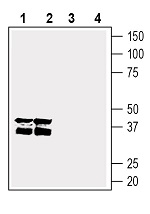Overview
- Peptide (C)RNRFILD(S)RMKQGIS, corresponding to amino acid residues 261 - 275 of mouse GPR55 (Accession Q3UJF0). 3rd extracellular loop.
- Rat and mouse brain membranes (1:500-1:2500).
 Western blot analysis of rat brain membranes (lanes 1 and 3), and mouse brain membranes (lanes 2 and 4):1, 2. Anti-GPR55 (extracellular) Antibody (#ACR-062), (1:500).
Western blot analysis of rat brain membranes (lanes 1 and 3), and mouse brain membranes (lanes 2 and 4):1, 2. Anti-GPR55 (extracellular) Antibody (#ACR-062), (1:500).
3, 4. Anti-GPR55 (extracellular) Antibody, preincubated with GPR55 (extracellular) Blocking Peptide (#BLP-CR062).
- Mouse BV-2 microglia cells (2.5 µg).
G protein coupled receptor 55 (GPR55) is a cannabinoid receptor activated by a number of endo‐, phyto‐ and synthetic cannabinoid ligands such as THC, JWH015 and anandamide1-3.
GPR55 is only 13.5% identical to the canonic cannabinoid receptor CB1 and 14.4% identical to CB2. Upon ligand binding, it initiates a signaling cascade quite distinct from those used by CB1 and CB2 that eventually leads to an increase in intracellular calcium levels.
GPR55 belongs to the Class A GPCRs. It shares many similarities with rhodopsin and as all other G-protein coupled receptors in its basic structure of seven transmembrane domains, intracellular C- terminus and extracellular N-terminal extensions4. The protein is highly expressed in large dorsal root ganglion neurons and its mRNA is present in the brain and periphery1.
GPR55 has a role in self‐renewing adult neural stem cell development and in hippocampal neurogenesis3. Experiments with mice in which GPR55 has been inactivated reveal a role for this receptor in neuropathic and inflammatory pain as well as in bone physiology. Thus deciphering the pharmacology of this receptor could lead to new therapeutics in these fields5.
